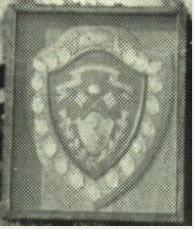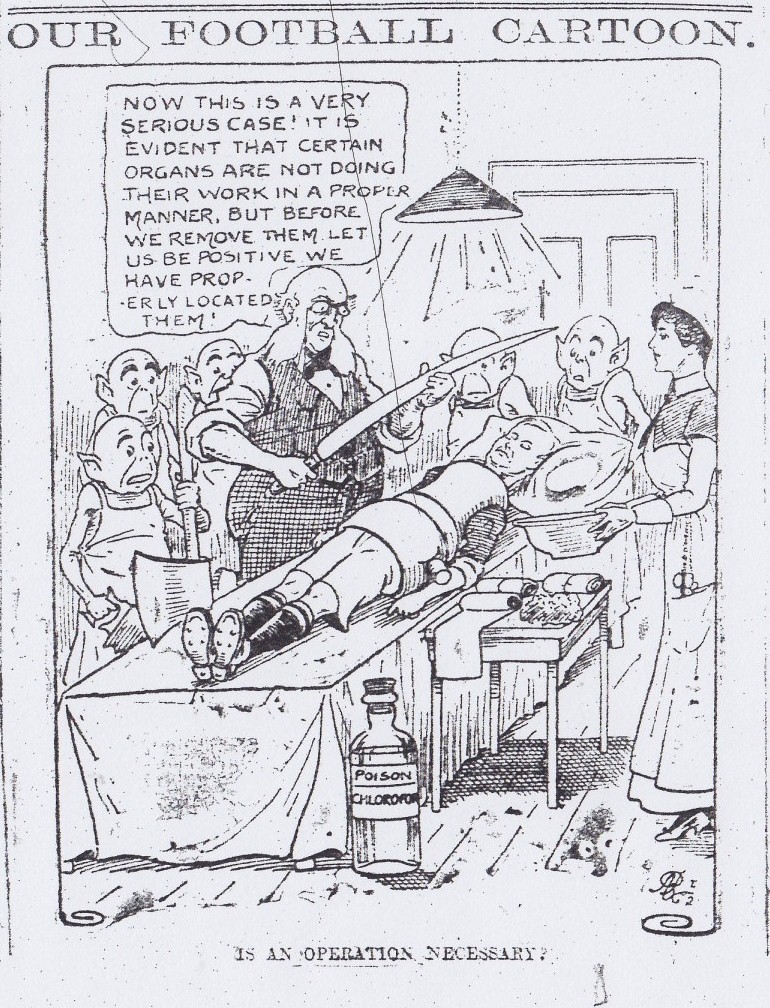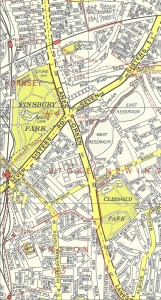by Andy Kelly
This weekly series charts Arsenal’s final season in Plumstead and the move to Islington that, effectively, saved the club’s very existence.
Wednesday 16th October 1912
Arsenal had a mid-week game at Crystal Palace in a relatively new competition – the Kent Senior Shield. It had been inaugurated the previous season and was won by Palace. It appears that the Kent FA were happy to allow entry to just about any team that played near Kent as Millwall also played in it.
This turned out to be Arsenal’s only time in the competition as being based in Islington is probably pushing the rules of entry into a Kent competition too far. However, Arsenal had an involvement in the Shield during the 1930s when Margate, who Arsenal had taken over as their “nursery” team, won it in 1935-36 and 1936-37, and were beaten finalists in 1937-38.
At the time of this game, Palace were in fifth place in the Southern League, one point behind the leaders, and had beaten Coventry 3-1 at the weekend.
Arsenal made six changes to the team that lost to Chelsea. Three were forced upon them with Shaw, Greenaway and McKinnon being selected to play for London against Birmingham on the same day. They were replaced by Ford, Lewis and Graham respectively. King came in for Sands in midfield whilst Flanagan replaced the mis-firing Common, and Spittle took Randall’s place.
Arsenal lined-up:
Crawford
Ford Peart
King Thomson Graham
Lewis Flanagan McLaughlan Spittle Winship
Crystal Palace’s team was:
Johnson
Colclough Balcock
Spottiswood Hanger York
Garratt Hewitt Williams Lloyd Davies
It was a dull afternoon and about 4,000 turned up.
With Arsenal’s team severely weakened and re-shuffled they struggled to gel. Crystal Palace were the best team in all departments and, but for the stubbornness of Arsenal’s defence and Crawford’s fine form, they would have racked up a big score. King conceded a penalty after 20 minutes when he handled inside the box. Thankfully, Crawford turned Balcock’s spot-kick around the post with his foot. The first half ended without a goal being scored.
Palace continued to press heavily in the second half to no avail. With five minutes to go the heavens opened and the home forwards seemed to relish this as Garratt, Hewitt and Davies combined with the latter finishing neatly from 10 yards out.
Another game, another defeat and, again, a poor performance from the attack.
Saturday 19th October 1912
Back to more important matters in the League at weekend.
Arsenal hosted a team from the North-East for the second time this season as Sunderland made the long journey to London.
Sunderland had had a worse start to the season than Arsenal. They were a point behind and their defence had let in seven more goals. Surely this was an opportunity for the forwards to get in some good practice?
Shaw, Sands and Randall returned, and the veteran Roddie McEachrane came in for his first game of the season in place of the injured McKinnon. Lewis retained his place on the right wing as Greenaway was ill.
Crawford
Shaw Peart
Thomson Sands McEachrane
Lewis Flanagan McLaughlan Randall Winship
Sunderland included two former Arsenal players in their team. Jackie Mordue had played 28 league and cup games on the wing in 1907 and 1908, whilst Charlie Buchan had played a couple of reserve games as an amateur in 1909-10.
Butler
Gladwin Milton
Cuggy Thomson Low
Mordue Buchan Hall Holley Martin
Both teams’ lowly positions were reflected in the attendance which was a very poor 8,724.
Sunderland won the toss and elected that Arsenal defend the Abbey Wood end. After some sloppy play the Reds settled into the game. McEachrane and Peart were commended for keeping Mordue and Buchan quiet. Arsenal’s fans thought that Lewis had scored early on but his shot hit the side netting. Mordue finally got the better of McEachrane but sent a shot over the bar – it seems that Sunderland had their own Alf Common. Holley went on a mazey run, with Flanagan tightly following him. Holley eventually fell over, sprawled out flat on the pitch. Flanagan was that close to him that he couldn’t avoid anything other than falling on top of the prostrate Sunderland forward. Flanagan put Lewis through twice in quick succession but he pushed the ball too far forward and Milton cleared. After 15 minutes the referee gave a dubious foul against McEachrane on Holley in the penalty area. Crawford wasn’t as lucky this time around and Mordue scored with a low shot. Follwing the re-start McLaughlan had a spell where he had a number of chances but found Butler and Gladwin the better of him. Arsenal then had a good attacking spell with Flanagan also hitting the side netting, Randall missing an open goal and McEachrane forcing a good save from a free-kick. But it was the same old story – no end product. Worryingly Crawford seemed to revert to his tactic of rushing out of the penalty area, obviously struggling with the new rule where goalies could only handle the ball inside their own penalty area. Half-time arrived with the score Woolwich Arsenal 0 Sunderland 1.
Arsenal started the second half on the offensive. Butler punched away a Winship free-kick and Thomson had a shot that was well wide. Sunderland were shell-shocked by the early onslaught and when they did manage to attack struggled to find anyone on the end of the final ball. The forwards had decided to change their tactics from “blazing the ball over the bar” to “hitting the side netting” as Winship became the third Reds player to do it. Sunderland then had a good spell but Arsenal’s defence continued to hold them at bay. Then SHOCK! HORROR! Arsenal scored! A long clearance found Flanagan who pushed the ball out to Lewis. A fine centre was met by McLaughlan who headed in. This rejuvenated Arsenal who had a 15 minute spell of constantly attacking the Sunderland goal. Sunderland’s defence resorted to all manner of play, fair and foul, to keep the home team at bay. However, very much like the Arsenal team of 100 years in the future, the Reds left themselves exposed at the back and the sucker punch was delivered against the run of play by Holley who shot across the goal past Crawford. Sunderland had the opportunity to extend their lead almost immediately with a shot going just over as Crawford was stranded. As Arsenal looked for an equaliser they were caught out again. Mordue swept down the left wing and scored his second of the game with another shot across the face of the goal. The game finished Woolwich Arsenal 1 Sunderland 3.
The story was becoming all too familiar. Arsenal dominated the play, the forwards were impotent, the defence was solid but they were struggling to continually support the front line. Until this game the local press were reporting Arsenal’s poor luck. Now it appeared that a team couldn’t be that unlucky all the time. There was something fundamentally wrong with the team and it needed to be changed. Worryingly, attendances were also suffering.
The Reds were now one place above the relegation zone, and only Notts County had scored fewer goals.
|
P |
W |
D |
L |
F |
A |
Pt |
GA |
||
|
1 |
Aston Villa |
10 |
6 |
2 |
2 |
29 |
11 |
14 |
2.64 |
|
2 |
BlackburnRovers |
10 |
4 |
4 |
2 |
22 |
14 |
12 |
1.57 |
|
3 |
BoltonWanderers |
9 |
6 |
0 |
3 |
15 |
10 |
12 |
1.50 |
|
4 |
NewcastleUnited |
9 |
4 |
4 |
1 |
12 |
9 |
12 |
1.33 |
|
5 |
ManchesterCity |
8 |
5 |
1 |
2 |
9 |
5 |
11 |
1.80 |
|
6 |
OldhamAthletic |
9 |
3 |
5 |
1 |
10 |
7 |
11 |
1.43 |
|
7 |
SheffieldWednesday |
8 |
5 |
1 |
2 |
15 |
21 |
11 |
0.71 |
|
8 |
West BromwichAlbion |
8 |
4 |
2 |
2 |
16 |
10 |
10 |
1.60 |
|
9 |
ManchesterUnited |
8 |
3 |
3 |
2 |
11 |
8 |
9 |
1.38 |
|
10 |
Everton |
9 |
4 |
1 |
4 |
15 |
11 |
9 |
1.36 |
|
11 |
DerbyCounty |
8 |
4 |
1 |
3 |
10 |
14 |
9 |
0.71 |
|
12 |
BradfordCity |
7 |
3 |
2 |
2 |
10 |
7 |
8 |
1.43 |
|
13 |
Liverpool |
10 |
4 |
0 |
6 |
14 |
16 |
8 |
0.88 |
|
14 |
Chelsea |
9 |
3 |
1 |
5 |
11 |
13 |
7 |
0.85 |
|
15 |
Middlesbrough |
8 |
2 |
3 |
3 |
7 |
11 |
7 |
0.64 |
|
16 |
SheffieldUnited |
8 |
2 |
2 |
4 |
15 |
17 |
6 |
0.88 |
|
17 |
Sunderland |
9 |
2 |
2 |
5 |
12 |
19 |
6 |
0.63 |
|
18 |
Woolwich Arsenal |
9 |
1 |
3 |
5 |
6 |
14 |
5 |
0.43 |
|
19 |
Tottenham Hotspur |
7 |
0 |
2 |
5 |
7 |
19 |
2 |
0.37 |
|
20 |
NottsCounty |
7 |
0 |
1 |
6 |
4 |
14 |
1 |
0.29 |
This was Sunderland’s second consecutive win. By mid-February they had put on such a magnificent run that they were top of the table, going on to eventually win the League title. They were also beaten finalists in the FA Cup.
The reserves travelled to the west country to play Bristol City (how they qualified for the South Eastern League, heaven knows).
William Burke, a 20-year-old amateur from West Ham, and Calder replaced McEachrane and Winship who were playing for the first team.
Wilson
Burke Ford
King Grant Graham
Calder Robertson Hanks Spittle Burrell
A miserable week was completed as the juniors lost 1-2. Spittle scored Arsenal’s goal. This left Arsenal fourth in the table but with games in hand over the teams above them.
At a meeting of the South Eastern League on 16th October it was reported that two of the players that Arsenal had been using were also playing Sunday football. The management committee felt that it was of sufficient importance to pass it on to the London FA to deal with.
As mentioned previously, Joe Shaw, David Greenaway and Angus McKinnon played in the London team that was thrashed 5-1 by Birmingham on 16th October. Bad news for Arsenal was that McKinnon limped off towards the end of the game.
The big news of the week was hidden away in a single paragraph of the Kentish Independent. No big headlines, which was strange. It had been reported in one of the London papers that Woolwich Arsenal’s directors had purchased a piece of land close to Harringay Park railway station and that, if the club could not be financially supported by the locals at Plumstead, permission would be asked of the Football League to relocate to North London. The report also mentioned that Tottenham and Orient would not be happy with the intrusion into their territory. When questioned, Arsenal manager, George Morrell, said that the reports were without foundation and only rumours, as removal of the club had not yet been considered.
As we now know, Arsenal did not move to this plot of land and we do not know if Norris and Hall actually bought the land. At the time it was occupied by the derelict Williamson’s Potteries. For those of you that know the area, it eventually went on to become Harringay Stadium which hosted dog racing, stock car racing and ice hockey. It is now a retail park. The map below (click to enlarge) is from the 1950s and shows Harringay Stadium and Highbury. Interestingly, when Arsenal did move to Highbury, George Morrell moved to Pemberton Road (top left of the map), a stone’s throw from the land that was alleged to have been bought.
Previous stories in this series:
14th October 1912 – The wheels start wobbling
7th October 1912 – Title winning form from Woolwich Arsenal
30th September 1912 – Another week, another point.
23rd September 1912 – Crisis? What crisis?
16th September 1912 – Woolwich Arsenal look set for a season of struggle
7th September 1912 – What was happening in Plumstead 100 years ago?
2nd September 1912 – The beginning of the end in Plumstead



